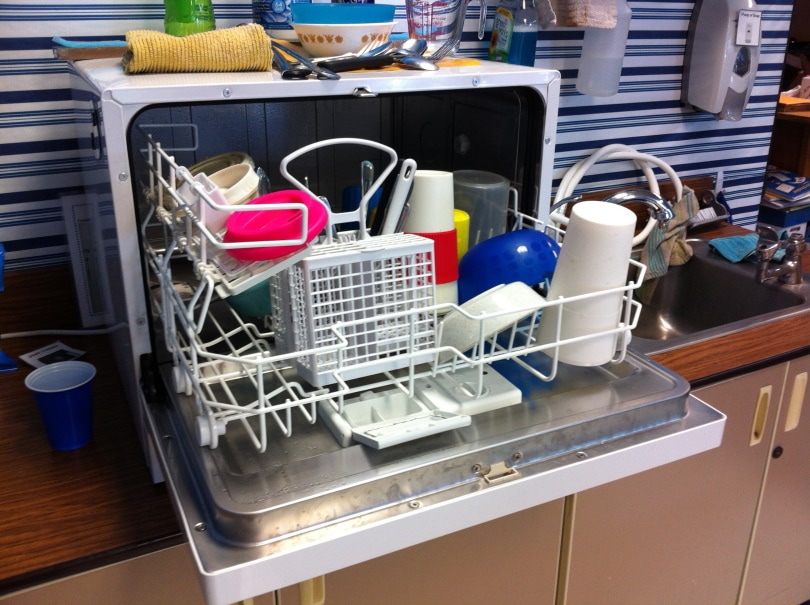Who Invented the Dishwasher, and When? History Explained
-

- Last updated:

Many early inventions were pioneered by people who wanted to make something that would help make life easier. One of the earliest inventions is the dishwasher—a machine designed to make cleaning a seemingly effortless task while saving time and energy. Joel Houghton was given the first patent to invent the dishwasher in 1850.
Today, thousands of models are available with fancy features and add-ons. We have created a concise article to tell you about the rich history of how the dishwasher came to be. Keep reading!

History of the Dishwasher
Before the invention of dishwashers, people relied mostly on elbow grease to clean their dishes. Ancient civilizations used liquids and sand to clean the dust and grime on dishes. While these methods may have worked, they were time-consuming. Besides, they ended up wearing out the hands of whoever did the washing. This invention took away some of the burden women would have when cleaning dishes at this point in time.

The 1800s Dishwasher Advancements
1850 – The Invention of the First Dishwasher
Joel Houghton invented the first dishwasher in 1850. He was a mechanical engineer and inventor who could only afford one servant to help him around the house. He was frustrated with how long it took to wash dishes. So, he decided to invent something that would help him do it. The device was a wooden box with holes at the top.
Water was poured over the dishes while they were placed on racks inside the box. It was not effective and was slow and undependable, but it was considered an improvement over hand washing.
1865 – L.A. Alexander Was Granted a Patent to Invent Another Dishwasher
The patent Alexander received was similar to the one Joel Houghton had. After seeing this machine in action, he applied these same principles to his own creation. The only difference between his invention and Joel Houghton’s was that his dishwasher had a hand-cranked rack system. This invention was also not widely accepted at the time and was impractical.

1887 – Josephine Cochrane Invented the Most Successful Dishwasher
Josephine Cochrane was a rich widow who had recently married her wealthy husband, William Cochrane, in 1858. She decided to design a device that could help her with the task. She sought the help of a man named George Butters because she didn’t have formal engineering education. Cochrane’s invention was not like modern-day dishwashers, but it inspired other inventors to create their versions over the next few decades. Hand pumps powered Cochrane’s first version. The water was heated using gas or coal stoves. Then, it was sprayed onto dirty dishes with soap suds, which were removed by a rubber squeegee. It also had an upper rack for drying dishes while being washed below by the spray jets of water coming out of the machine’s front opening grille.
The 1900s Dishwasher Advancements
1924 – William Howard Livens Invented Dishwasher for Domestic Use
The dishwasher William Howard Livens invented had many features of the dishwasher used today. It had several components, such as a wire rack to hold dirty utensils and a rotating sprayer.
The machine was intended to be operated by hand. It used soap powder as its cleaning agent. It also consisted of two large trays that were filled with water. The dirty dishes were placed in one tray. Then, they were covered with a second tray with holes cut into it. This way, water could drain through into the lower tray. Later, in 1940, the dishwasher design had an add-on: drying elements.
1970 – Dishwashers Become Widespread
Josephine Cochrane’s invention was widely accepted. Manufacturers began producing dishwashers commercially. This included small dishwashers that could fit in most kitchens. They became more affordable and widespread.
During this time, dishwashers became a standard feature in many households worldwide, especially in Western Europe and North America as well as other developed countries. About 80% of Americans have a dishwasher.

Late 1990 – More Features Added to Dishwashers
Dishwasher manufacturers started including many features, such as wash cycles and digital controls. The primary feature added to dishwashers is the sensor. It allows the machine to detect when it’s full of dishes, so it doesn’t overflow onto the floor.
Another crucial feature added to dishwashers is the automatic dispenser for detergent. It allows you to fill your dispenser with whatever brand of detergent you prefer. Besides, it eliminates the need for measuring detergent before every load of dishes.
- See also: Who Invented the Kitchen Stove & When?
21st Century – Present-Day Dishwashers
Modern dishwashers are a far cry from their predecessors. They are more efficient and user-friendly. They have extra features to achieve more than older models. These features include:
- Adjustable Racks: The racks in a modern dishwasher are adjustable. You can place them at different heights. It’s easy to accommodate all dishes, from small glasses to tall pots and pans.
- A Third Rack: It’s an excellent addition to your dishwasher. You can use the third rack for wine glasses or delicate items that you cannot place on the bottom rack. It’s narrower than the other racks.
- Soil Sensors: These sensors detect how dirty your dishes are. They also determine how much time and water the machine needs to run for optimal cleaning.
- Wash Zones: These are innovative additions to your dishwasher. They allow you to customize the cleaning process for different dishes and utensils.
- WI-FI Connectivity and Smart-Home Technology: Modern smart dishwashers can connect to your home’s Wi-Fi. You can control them remotely with an app on your smartphone or tablet.
- Rinse/Hold Cycle: With this feature, you can run a rinse cycle before the main wash cycle. It’s helpful when washing large dishes or pots that may be challenging to clean due to design.


Conclusion
As the saying goes, necessity is the mother of invention. It’s no surprise that early inventors created many clever and efficient innovations out of necessity. The dishwasher is among the quiet servants of our modern society—a labor-saving device we would hate to live without.
Many people contributed to the success of the dishwasher. They dedicated their time and resources to developing this invention. Also, they helped advance the dishwashing industry.
- 1850 – Invention of the First Dishwashers
- 1865 – L.A. Alexander was granted a Patent to Invent another Dishwasher
- 1887 – Josephine Cochrane Invented the Most Successful Dishwasher
- Components of the First Automatic Dishwasher
- 1924 – William Howard Livens invented a Small, Non-Electric Dishwasher for Domestic Use
- 1970 – Dishwashers became Widespread
- Late 1990 – More Features added to Dishwashers
- Extra Features of Modern Dishwashers
- AMICA INTERNATIONAL
- GRIST
- HOOVER
Featured Image Credit: Leszek Glasner, Shutterstock
Contents

